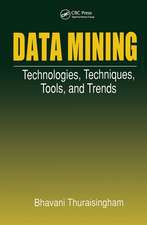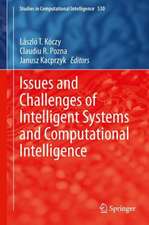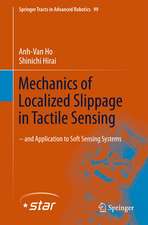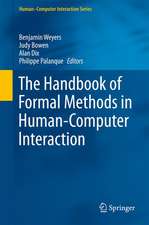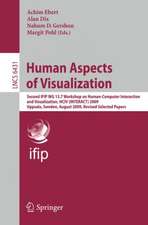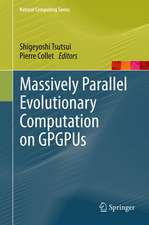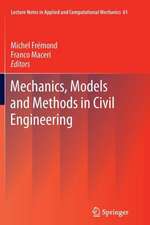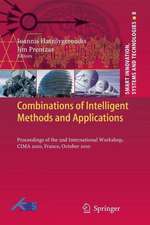An Introduction To Artificial Intelligence
Autor Janet Finlayen Limba Engleză Hardback – 28 iul 2017
Throughout the volume, the authors provide detailed, well-illustrated treatments of each topic with abundant examples and exercises. The authors bring this exciting field to life by presenting a substantial and robust introduction to artificial intelligence in a clear and concise coursebook form. This book stands as a core text for all computer scientists approaching AI for the first time.
| Toate formatele și edițiile | Preț | Express |
|---|---|---|
| Paperback (1) | 415.95 lei 6-8 săpt. | |
| CRC Press – 27 iun 1996 | 415.95 lei 6-8 săpt. | |
| Hardback (1) | 1014.74 lei 6-8 săpt. | |
| CRC Press – 28 iul 2017 | 1014.74 lei 6-8 săpt. |
Preț: 1014.74 lei
Preț vechi: 1441.89 lei
-30% Nou
Puncte Express: 1522
Preț estimativ în valută:
194.17€ • 203.27$ • 160.66£
194.17€ • 203.27$ • 160.66£
Carte tipărită la comandă
Livrare economică 05-19 aprilie
Preluare comenzi: 021 569.72.76
Specificații
ISBN-13: 9781138435841
ISBN-10: 1138435848
Pagini: 286
Dimensiuni: 156 x 234 x 22 mm
Greutate: 0.45 kg
Ediția:1
Editura: CRC Press
Colecția CRC Press
ISBN-10: 1138435848
Pagini: 286
Dimensiuni: 156 x 234 x 22 mm
Greutate: 0.45 kg
Ediția:1
Editura: CRC Press
Colecția CRC Press
Public țintă
UndergraduateCuprins
Preface -- Introduction -- What is artificial intelligence? History of artificial intelligence The future for AI -- 1 Knowledge in AI -- 1.1 Overview -- 1.2 Introduction -- 1.3 Representing knowledge -- 1.4 Metrics for assessing knowledge representation schemes -- 1.5 Logic representations -- 1.6 Procedural representation -- 1.7 Network representations -- 1.8 Structured representations -- 1.9 General knowledge -- 1.10 The frame problem -- 1.11 Knowledge elicitation -- 1.12 Summary -- 1.13 Exercises -- 1.14 Recommended further reading -- 2 Reasoning -- 2.1 Overview -- 2.2 What is reasoning? -- 2.3 Forward and backward reasoning -- 2.4 Reasoning with uncertainty -- 2.5 Summary -- 2.6 Exercises -- 2.7 Recommended further reading -- 3 Search -- 3.1 Introduction -- 3.2 Exhaustive search and simple pruning -- 3.3 Heuristic search -- 3.4 Knowledge-rich search -- 3.5 Summary -- 3.6 Exercises -- 3.7 Recommended further reading -- 4 Machine learning -- 4.1 Overview -- 4.2 Why do we want machine learning? -- 4.3 How machines learn -- 4.4 Deductive learning -- 4.5 Inductive learning -- 4.6 Explanation-based learning -- 4.7 Example: Query-by-Browsing -- 4.8 Summary -- 4.9 Recommended further reading -- 5 Game playing -- 5.1 Overview -- 5.2 Introduction -- 5.3 Characteristics of game playing -- 5.4 Standard games -- 5.5 Non-zero-sum games and simultaneous play -- 5.6 The adversary is life! -- 5.7 Probability -- 5.8 Summary -- 5.9 Exercises -- 5.10 Recommended further reading -- 6 Expert systems -- 6.1 Overview -- 6.2 What are expert systems? -- 6.3 Uses of expert systems -- 6.4 Architecture of an expert system -- 6.5 Examples of four expert systems -- 6.6 Building an expert system -- 6.7 Limitations of expert systems -- 6.8 Hybrid expert systems -- 6.9 Summary -- 6.10 Exercises -- 6.11 Recommended further reading -- 7 Natural language understanding -- 7.1 Overview -- 7.2 What is natural language understanding? -- 7.3 Why do we need natural language understanding? -- 7.4 Why is natural language understanding difficult? -- 7.5 An early attempt at natural language understanding: SHRDLU -- 7.6 How does natural language understanding work? -- 7.7 Syntactic analysis -- 7.8 Semantic analysis -- 7.9 Pragmatic analysis -- 7.10 Summary -- 7.11 Exercises -- 7.12 Recommended further reading -- 7.13 Solution to SHRDLU problem -- 8 Computer vision -- 8.1 Overview -- 8.2 Introduction -- 8.3 Digitization and signal processing -- 8.4 Edge detection -- 8.5 Region detection -- 8.6 Reconstructing objects -- 8.7 Identifying objects -- 8.8 Multiple images -- 8.9 Summary -- 8.10 Exercises -- 8.11 Recommended further reading -- 9 Planning and robotics -- 9.1 Overview -- 9.2 Introduction -- 9.3 Global planning -- 9.4 Local planning -- 9.5 Limbs, legs and eyes -- 9.6 Practical robotics -- 9.7 Summary -- 9.8 Exercises -- 9.9 Recommended further reading -- 10 Agents -- 10.1 Overview -- 10.2 Software agents -- 10.3 Co-operating agents and distributed AI -- 10.4 Summary -- 10.5 Exercises -- 10.6 Recommended further reading -- 11 Models of the mind -- 11.1 Overview -- 11.2 Introduction -- 11.3 What is the human mind? -- 11.4 Production system models -- 11.5 Connectionist models of cognition -- 11.6 Summary -- 11.7 Exercises -- 11.8 Recommended further reading -- 11.9 Notes -- 12 Epilogue: philosophical and sociological issues -- 12.1 Overview -- 12.2 Intelligent machines or engineering tools? -- 12.3 What is intelligence? -- 12.4 Computational argument vs. Searle's Chinese Room -- 12.5 Who is responsible? -- 12.6 Morals and emotions -- 12.7 Social implications -- 12.8 Summary -- 12.9 Recommended further reading -- Bibliography -- Index.
Descriere
Offers an accessible and comprehensive introduction to artificial intelligence. Featuring extensive worked examples and exercises, the text is suitable for modular undergraduate degrees or MSc conversion courses.






